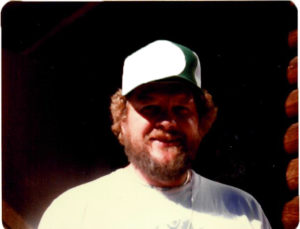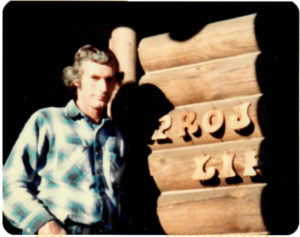Camp Colton: The Origin Story
A short history of Flagstaff’s iconic environmental camp for kids

Ed Piper at Camp Colton, 1980.
Over the past 51 years, the Camp Colton experience has given more than 45,000 kids in the greater Flagstaff community the chance to explore their local natural environment. The foundation of this long-standing program is outdoor environmental education, something that is more important than ever as our region faces the effects of climate change and catastrophic wildfire.
How did the Camp Colton program begin?
Dedicated teachers and school leaders are at the heart of many local programs, and Camp Colton is no exception. In 1971, Sechrist Elementary School sixth-grade teachers Ed Piper and Bob Dawson, along with Sechrist Principal Tony Gabaldon, started Project LIFE (Life in the Flagstaff Environment). Bob and Tony are now deceased, but their legacy continues. Ed fondly remembers the inception of the program that became Camp Colton.

Bob Dawson at Camp Colton, 1980.
After attending a summer outdoor program in California in 1971, Bob returned full of new ideas. Along with the passion that Bob and Ed shared for outdoor environmental education, these ideas led to the creation of Project LIFE. When they discussed their vision with Tony, he was equally inspired, and they all worked together to make this program possible for all Flagstaff Unified School District sixth-graders.
Project LIFE moves to Hart Prairie and becomes Camp Colton
Originally held at various sites around Mormon Lake, Project LIFE moved to its current location in 1976 when Dick and Jean Wilson deeded the 33-acre Hart Prairie property and camp facilities to FUSD. To this day, the Wilson family continues to generously support student access and outdoor environmental education programs at Camp Colton.
Located on the western slope of the San Francisco Peaks at an elevation of nearly 9,000 feet, the property is in an ecologically significant and beautiful off-grid setting where students are immersed in nature and sustainable living. In honor of the generous donation, FUSD renamed the program “Camp Colton” after Suzanne Colton Wilson, Dick Wilson’s mother and sister of Dr. Harold S. Colton, founder of the Museum of Northern Arizona.
Camp Colton experiences for kids through the years
“Project LIFE was not just about going camping; it was an outdoor education experience. Kids learned about their local environment and how to do new things like rock climbing, using a map and compass, and square dancing,” shares Ed.
Ed worked as a teacher with FUSD for 31 years, mostly as a sixth-grade teacher at Sechrist. Bob also taught at Sechrist for most of his 29-year career in the district. When Project LIFE began, many of the activities were driven by the teachers’ interests. Bob was an avid rock climber, and he made rock climbing part of Project LIFE at Mormon Lake and Camp Colton. Ed loved teaching kids about local wildlife with skulls and antlers.
Rock climbing no longer occurs at Camp Colton; however, 6th graders still learn about local ecology, including native plants and animals, food webs, and interact with plastic recreations of skulls, antlers, and scat (animal droppings). Kids at Camp still experience other traditions from Project LIFE, such as archery and square dancing. Learn more about our current programs.
According to Ed, kids, teachers, and parents alike loved Project LIFE—love that has continued and sustained the 51-year legacy of Camp Colton. Read some of our stories about Flagstaff locals, like David Abeyta, who went to Camp Colton in 1977, and Lisa Lamberson, who went to Camp in 1989.
If you’ve been part of this legacy, either as a staff member or a student, we’d love to hear from you. Share your stories with us.

